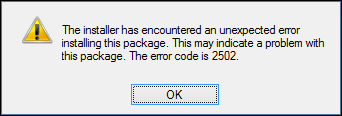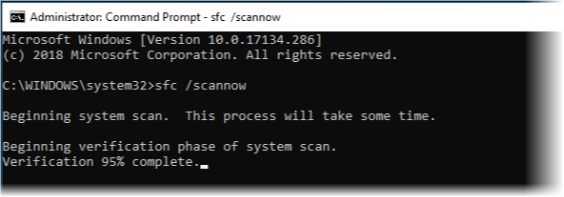Troubleshooting error 2502 while installing inSync Client
This article applies to:
- OS: Windows 7 and later
- Product edition: inSync Client
Problem description
The following unexpected error is displayed while manually installing Druva inSync Client on a Windows system.

Causes
- Microsoft Windows Installer crashes while installing the inSync Client.
- Pending operations which are stuck on the device from previous installations.
- Programs currently running on the device and interfering with the installation.
- Permission issue on Windows Installer Registry.
- Corruption in Windows system32, that can be addressed with the help of re-projecting files from the Component store (WinSXS) using SFC (System File Checker) tool.
- Check windows event viewer for relevant msi errors in system and application logs.
Resolution
Login to your Windows device as an administrator before you troubleshoot the Windows Installer issues.
Troubleshoot the installer issues in the following order:
- Identify Windows Installer issues
- Check for excessively long file and folder names
- Check for a pending reboot from a previous installation
- Try a clean boot
- Try to run the System File Checker Tool (an in-built tool in Windows)
- Enable MSI logging and read the .msi verbose log files
Identify Windows Installer issues
Microsoft Windows Installer is a component of the Windows operating system. Windows Installer provides a standard foundation for installing and uninstalling software. Software manufacturers can create a setup of their products to use Windows Installer to help make software installation, maintenance, and uninstallation straightforward and easy.
Program installation issues may arise if the Windows Installer engine is corrupted, disabled, or installed incorrectly.
Use the following methods to identify any Windows Installer issues that may be causing problems when you install, uninstall, or update programs.
Determine whether the Windows Installer service is running
- Open the Windows command prompt.
- Run the below command and check for error messages.
MSIExec
The MSI engine is working fine if the command does not display any error messages. - Install or uninstall again.
Ensure the Windows Installer service is enabled
- Click Start and type services.msc in the Search box or click Run then type services.msc in the dialog and then press Enter to open Services.
- Open the services list using one of the below methods:
- Enter services.msc in the Search box and press Enter.
- Open the Run window, enter services.msc and press Enter.
- Right-click on Windows Installer and click Properties.
- Check whether the Startup type field is set to Manual. If it is set to Disabled, change it to Manual.
- Click OK.
- Right-click the Windows Installer service and click Start from the menu. The service must start without errors.
- Install or uninstall again.
Register the installer engine again
- Open a Command Prompt window.
- Run the following commands
MSIExec /unregister
MSIExec /regserver

- Install or uninstall again.
Check the installer version
Run the below command from the command prompt.
msiexec
The installer version is displayed in a new window.

Windows Installer 4.5 is released with Windows Vista, Windows XP, Windows Server 2003 and Windows Server 2008 SP2.
Windows Installer 5.0 is the latest Windows Installer for Windows 7, 8, 8.1, Windows Server 2008 R2, 2008 R2 SP1, 2012 and 2012 R2 and later.
There is no redistributable package for Windows Installer 5.0. Hence, in the case of Windows 8, you have to download the Windows 8 Software Development Kit, which will provides access to a fresh copy of Windows Installer 5.0.
Reference: What’s New in Windows Installer 5.0
Check permission on Windows Installer registry
If the Windows Installer continues to have issues, clean some of the data from your system registry that may be corrupting the installer.
Modifying the registry settings incorrectly can make your system unusable.
Before attempting this resolution, back up your files and create a system restore point.
Procedure:
- Open the command prompt run the below command:
regedit
- Click Yes if Windows asks your permission for the Registry Editor to make changes to your system.
- Navigate to HKEY_LOCAL_MACHINE\Software\Microsoft\Windows\CurrentVersion\Installer\
- Right-click on the Installer folder and select Permissions.
- Click SYSTEM and ensure Full Control is enabled (checked).
Check for excessively long file and folder names
Make sure you do not have files or folder names that are longer than 260 characters.
For more information about the maximum path length limitation, see Naming files, paths, and namespaces.
Check for a pending reboot from a previous installation
Whenever a software, package, component, role or feature (in Windows servers) is installed, some of them might get implemented immediately, where as some might need a reboot. Such packages which that have to be implemented after a Windows reboot may remain stuck in the same stage until the system is restarted.
You can verify such packages via the registry keys and remove the pending entries to confirm there are no packages stuck in pending list and which could cause stall the client installation.
Back up your registry before making any changes to it. Export it to a separate location so save a copy in case you need to roll back.
To remove an orphaned UpdateExeVolatile registry key value:
- Open a registry editor, such as Regedit.exe.
- Navigate to HKLM\SOFTWARE\Microsoft\Updates\
- In the right navigation pane, double-click the UpdateExeVolatile key.
- Configure the key with a value of 0.
- Close the Registry Editor.
HKEY_LOCAL_MACHINE\SOFTWARE\Microsoft\Updates\UpdateExeVolatile - The UpdateExeVolatile key has to do with software installations, and if it gets messed up it can cause a problem with Windows Installer.
To delete the orphaned PendingFileRenameOperations registry key:
- Open a registry editor, such as Regedit.exe.
- Navigate to HKLM\SYSTEM\CurrentControlSet\Control\Session Manager\.
- In the right navigation pane, right-click the PendingFileRenameOperations key and select Delete.
- Close Registry Editor.
HKEY_LOCAL_MACHINE\SYSTEM\CurrentControlSet\Control\Session Manager\PendingFileRenameOperations - As explained above, if there are any pending reboots from previous installation, it would not allow existing software to get installed. So deleting would clear these entries and we can try to install or product again.
Note : If both the above keys do not exist in the registry, it means there are no pending operations and updates in the system from the Windows registry stand point. You can directly proceed to Try to run System File Checker Tool.
Try a clean boot
This action is performed to remove interference in the installation process from the programs that are currently running on your system.
To disable the program causing the interference in installation:
- Click Start and enter msconfig in the Search box, and then click msconfig.exe.
- Enter the administrator credentials if prompted or provide confirmation.
- On the General tab, click Selective startup, and then clear the Load startup items check box.
- Click Services, click Hide all Microsoft services, and then click Disable all.
- Click OK, and then click Restart.
- Try running your software program installation.
- When you are finished troubleshooting the problem, restart the system in the Normal Startup mode in the following order:
- Click Start and enter msconfig in the Search box, and then click msconfig.exe.
- Enter the administrator credentials if prompted by the system or provide confirmation.
- On the General tab, click Normal startup, click OK, and then click Restart.
Try to run the System File Checker Tool (an in-built tool in Windows)
The sfc /scannow command scans all the protected system files and replaces the corrupt files with a cached copy located in a compressed folder at %WinDir%\System32\dllcache.
The %WinDir% placeholder represents the Windows operating system folder. For example, C:\Windows.
On Windows 8, 8.1, and 10: Run the Inbox Deployment Image Servicing and Management (DISM) tool prior to running the System File Checker as described below.
Type the following command, and then press Enter. The command operation may take several minutes to complete.
DISM.exe /Online /Cleanup-image /Restorehealth
When you run the above command, DISM uses Windows Update to provide the files that are required to fix the corruption. However, if your Windows Update client is already broken, use one of the following as the source of the files:
- A running Windows installation as the repair source
- A Windows side-by-side folder from a network share or from a removable media, such as the Windows DVD
To do this, run the following command instead:
DISM.exe /Online /Cleanup-Image /RestoreHealth /Source:C:\RepairSource\Windows /LimitAccess
Replace the C:\RepairSource\Windows placeholder in the above command with the location of your repair source. For more information about using the DISM tool to repair Windows, reference Repair a Windows Image.
On Windows 7 or Windows Vista: If some Windows functions are not working or if Windows crashes, use the System File Checker to scan Windows and restore your files.
At the command prompt, type the following command, and then press ENTER:
Run the following command from the command prompt.
sfc /scannow

The sfc /scannow command scans all the protected system files and replaces the corrupted files with a cached copy that is located in a compressed folder located at %WinDir%\System32\dllcache.
The %WinDir% placeholder represents the Windows operating system folder. For example, C:\Windows.
Do not close the command prompt window until the verification is 100% complete. The scan results will be displayed at the end of the process.
At the end of the process , you may receive one of the following messages:
| Message | Description/Action required |
|---|---|
| Windows Resource Protection did not find any integrity violations. | This means that you do not have any missing or corrupted system files. |
| Windows Resource Protection could not perform the requested operation. |
To resolve this problem, perform the System File Checker scan in safe mode, and make sure that the PendingDeletes and PendingRenames folders exist under %WinDir%\WinSxS\Temp. |
| Windows Resource Protection found corrupt files and successfully repaired them. Details are included in the CBS.Log %WinDir%\Logs\CBS\CBS.log. | To view the detailed information about the system file scan and restoration, go to How to view details of the System File Checker process. |
| Windows Resource Protection found corrupt files but was unable to fix some of them. Details are included in the CBS.Log %WinDir%\Logs\CBS\CBS.log. | To repair the corrupted files manually, view details of the System File Checker process to find the corrupted file, and then manually replace the corrupted file with a known good copy of the file. |
Additional references: For further troubleshooting and log analysis related to SFC, see Use the System File Checker tool to repair missing or corrupted system files.
Enable MSI logging and read the .msi verbose log files
Most programs create an installation log. If you fail to locate such a log, you can enable verbose MSI logging. For more information, see How to enable Windows Installer logging.
If you run the .msi log file without the bootstrapping application (.exe), you can add parameters for verbose logging. For example, you can run the following command:
Msiexec path_to_your_msi.msi /L*v path_to_your_msi_log.txt
For a list of msiexec command-line parameters, see Command-line options.
A failed installation typically logs Return Value 3 where the problem occurred and where the installation rollback began. The description of the failure appears immediately before the Return Value 3 log entry.

